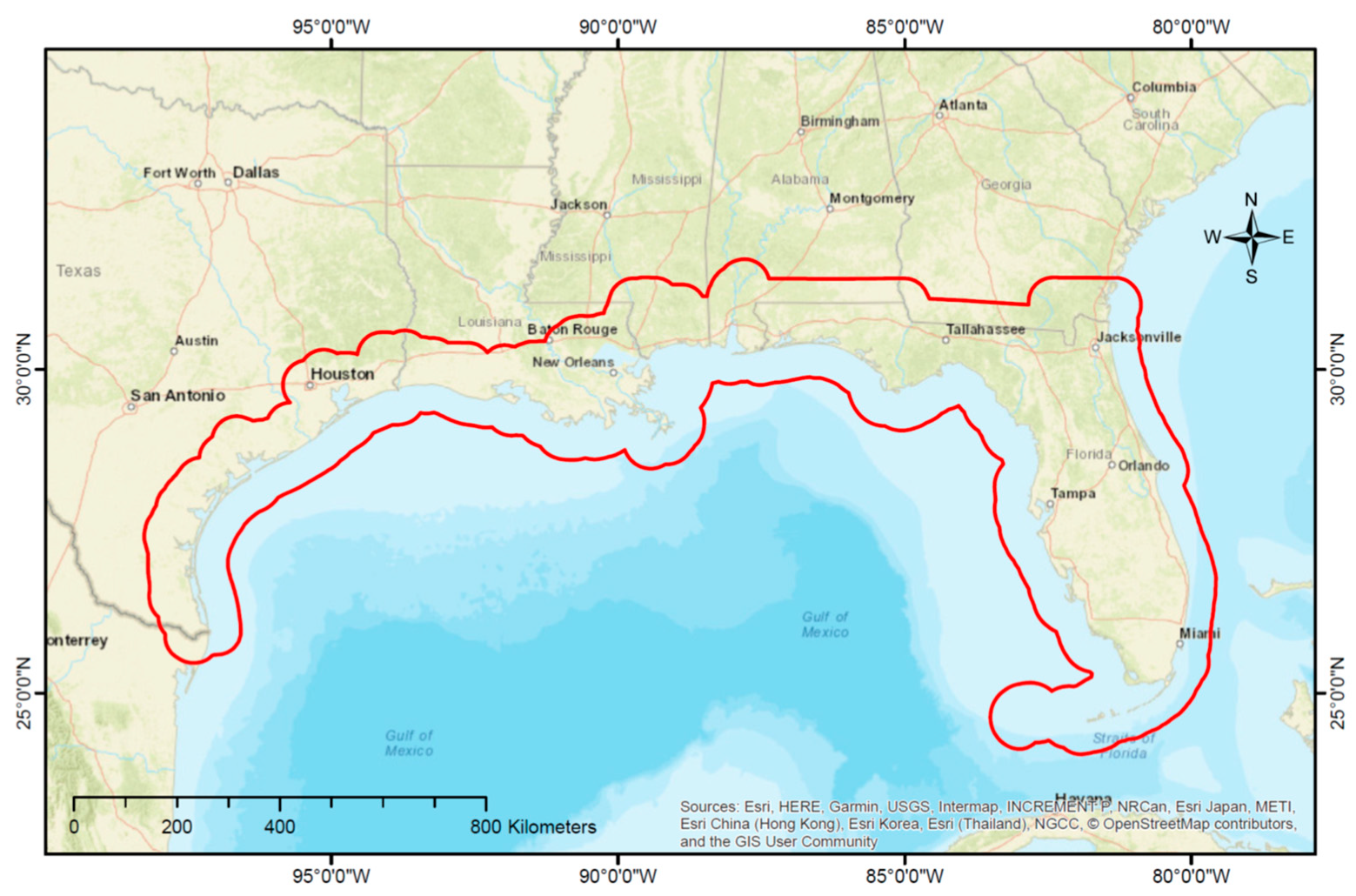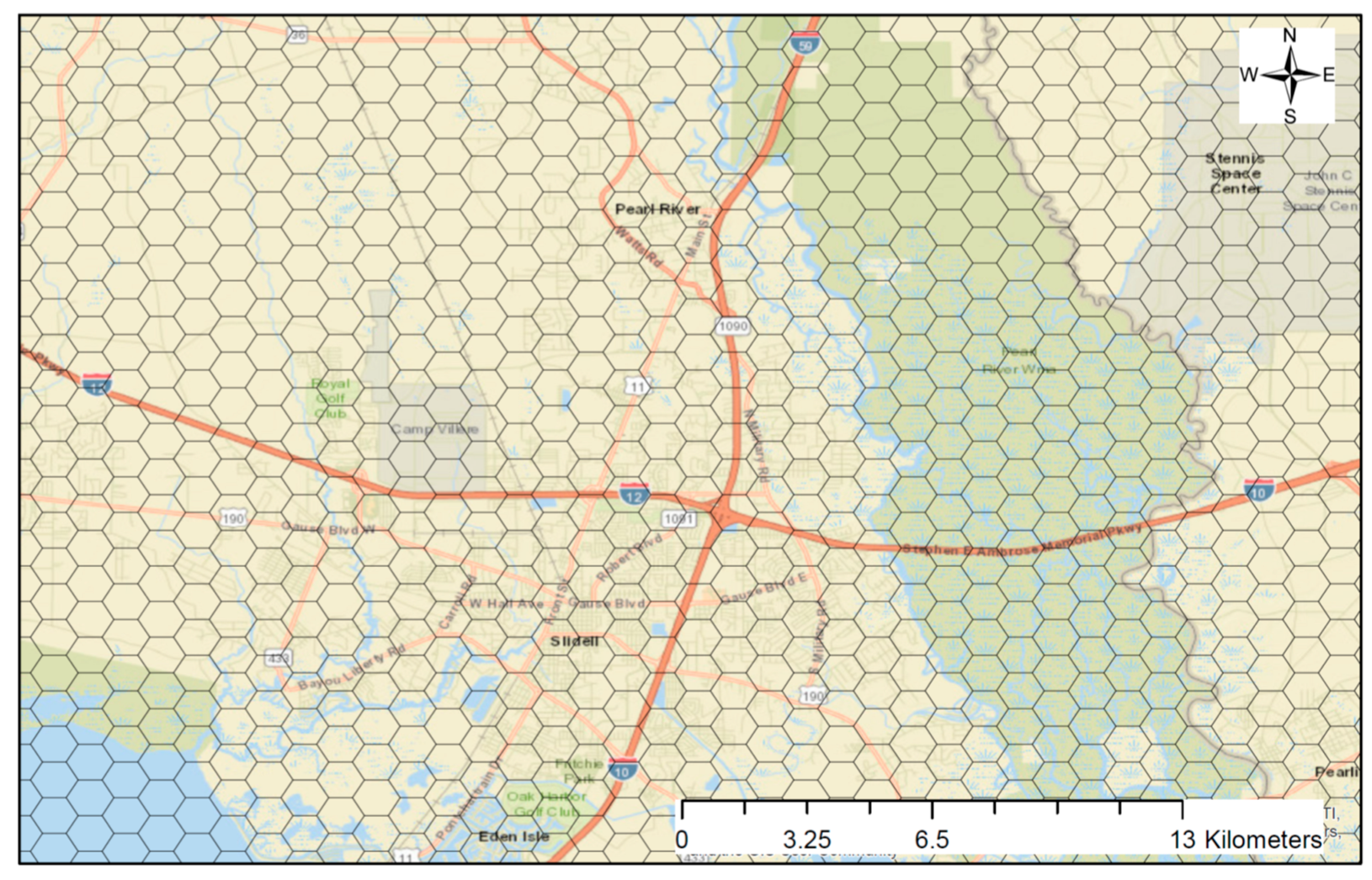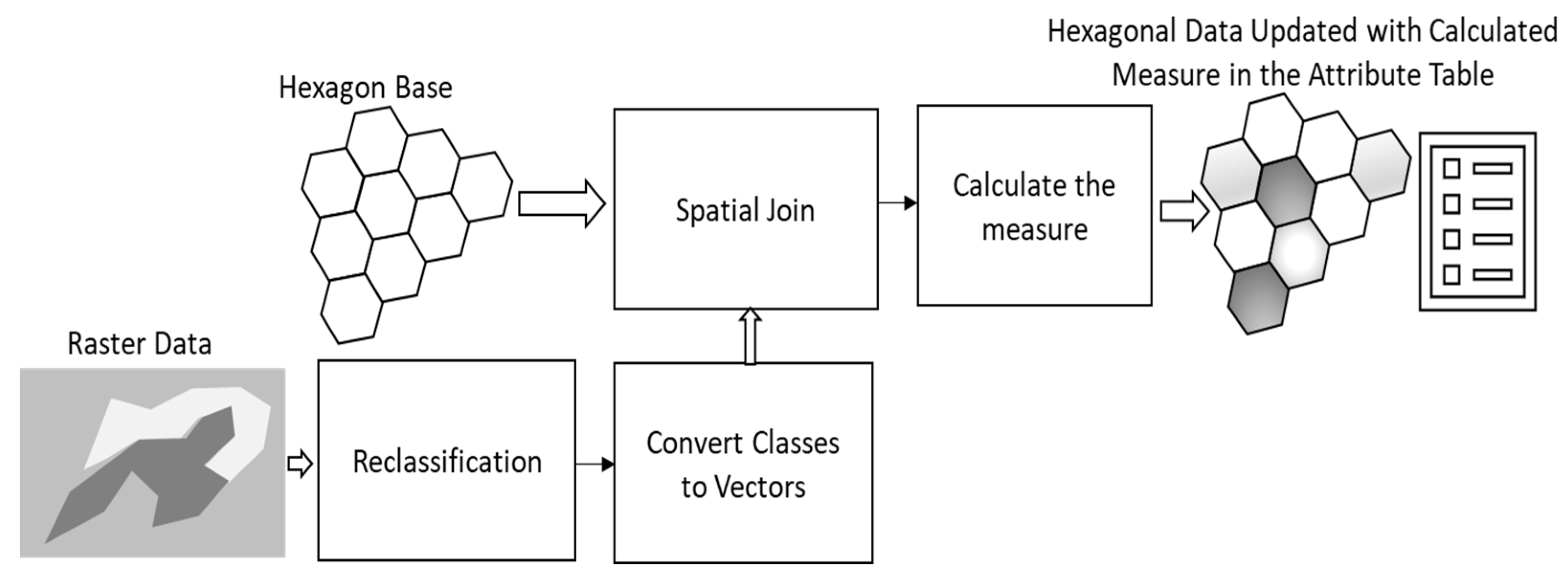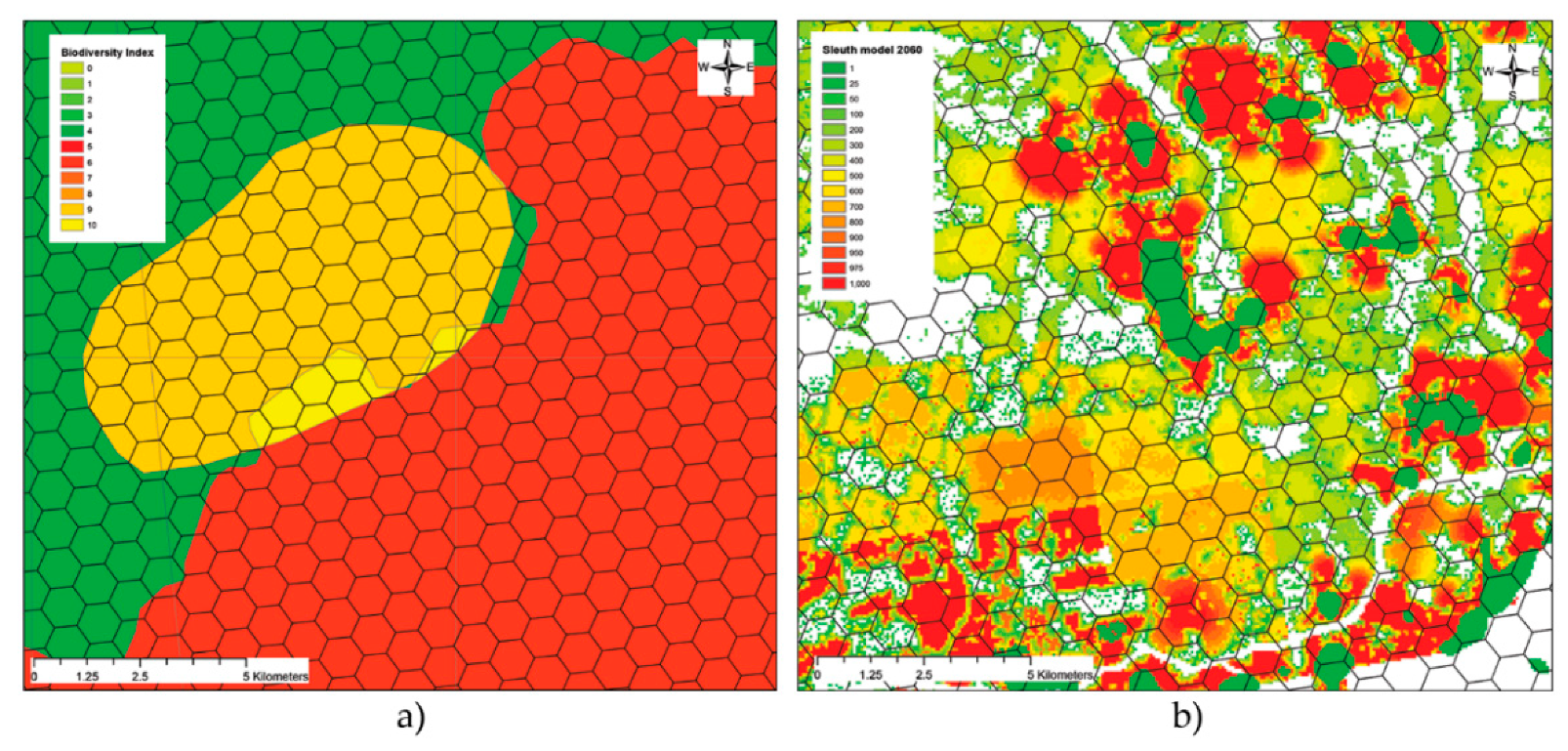Multi-Attribute Ecological and Socioeconomic Geodatabase for the Gulf of Mexico Coastal Region of the United States
Abstract
1. Summary
2. Data Description
3. Methods
3.1. Hexagon Grid
3.2. Data Processing Workflow
3.3. Data Overview
4. User Notes
Supplementary Materials
Author Contributions
Funding
Acknowledgments
Conflicts of Interest
Appendix A. Definition and Implementation of Database Measures
Appendix A.1. Threat of Urbanization
- Reclassify raster values from 0–1000 in 16 classes (1 to 1000), where Ai represents the area of the ith class within a hexagon).
- Convert individual classes to vectors.
- Crop the vector classes to hexagon boundaries, and perform spatial joins to obtain areas of each vector class within hexagons.
- ToU is then calculated as shown in Equation (A1).
Appendix A.2. Connectivity to Existing Protected Area
- Create a 1 km buffer around PAD-US 2.0 data.
- Perform spatial overlay of the PAD-US 2.0 buffer with hexagon boundaries
- Classify the hexagons as connected (one) or not connected (zero) based on the overlap between a hexagon and the buffer
Appendix A.3. Structural Connectivity
- Convert the Intact Habitat Cores layer to vector format.
- Merge Hub and Connectivity layers.
- Perform spatial join with hexagon boundaries to extract areas.
Appendix A.4. Composition of Natural Lands
- Mosaic TX, FL, and GAP data together.
- Compile appropriate classes within assigned categories.
- Resample TX to 30 m resolution.
- Rank classifications of landcover within the hexagons (see Table A1).
| Tier 1 | State Wildlife Action Plan (SWAP) Tier 1 habitats Gulf Coast Vulnerability Assessment ecosystems: mangrove tidal emergent marsh oyster reef barrier islands LCC priority habitats: GCP LCC, GCPO LCC, PF LCC Other prioritized natural lands not overlapping with Tier 1 |
| Tier 2 | managed pine rangelands hay crop lands low density residential |
| Tier 3 | urban commercial barren open water |
Appendix A.5. 303(d): Impaired Watershed Area
- Clip the impaired watershed boundary layer with hexagon boundaries.
- Perform spatial join to calculate the proportion of each hexagon that contains an impaired watershed.
Appendix A.6. Hydrologic Response to Land Use Change
- Perform spatial join of the vector data with hexagon boundaries.
- Compute mean of percent change in peak flow values within each hexagon.
Appendix A.7. Stream Abundance
- Clip the NHD Snapshot stream vectors to the hexagon boundaries.
- Calculate the length of all streams within each hexagon.
Appendix A.8. Biodiversity Index
- Classify the raster into 10 classes.
- Vectorize 10 classes.
- Perform spatial join with the hexagon boundaries.
- Compute the mean of biodiversity values within each hexagon.
Appendix A.9. Threatened and Endangered Species Critical Habitat Area
- Exclude the species not found in the SCA region and the areas of critical habitat not contained in the SCA region.
- For each species i, calculate the proportion of critical habitat for species in the SCA region contained within a hexagon (Asi) using Equation (A2).
- Calculate T&E percent area using Equation (A3).
Appendix A.10. T&E Species Counts
- Perform spatial join of the data with hexagon boundaries.
- Obtain the counts within each hexagon.
Appendix A.11. Light Pollution Index
- Reclassify raster values from 0–30 to zero (Z), low (L), medium (M), and high (H) as per the thresholds shown in Table A2 below.
- Convert Z, L, M, and H classes to vectors.
- Crop the vector classes to hexagon boundaries and perform spatial joints to obtain areas (AZ, AL, AM, and AH).
- The LP index is then calculated as shown in Equation (A4).
| Class | LP Score |
|---|---|
| AZ | 0 |
| AL | 1–10 |
| AM | 11–20 |
| AH | 21–30 |
Appendix A.12. National Register of Historic Places
- Perform spatial join of the data with hexagon boundaries.
- Obtain the counts within each hexagon.
Appendix A.13. National Heritage Area
- Clip the national heritage area data to hexagon boundaries.
- Perform spatial join to obtain the area within each hexagon.
Appendix A.14. Proximity to Socially Vulnerable Communities
- Clip NOAA’s Social Vulnerability Index to hexagon boundaries.
- Perform spatial join to obtain the Social Vulnerability Index within 1 km of each hexagon.
Appendix A.15. Community Threat Index
- Transform the CTI raster data to a vector shapefile.
- Perform spatial join to obtain the CTI within each hexagon.
Appendix A.16. Working Lands: High Priority
- Extract the target layers from NLCD 2016 to a new raster file.
- Transform the raster data to a vector shapefile.
- Perform spatial join to calculate the percent area within each hexagon.
Appendix A.17. Commercial Fishing Reliance
- Clip the Commercial fishing reliance data to hexagon boundaries.
- Perform spatial join to obtain the commercial fishing reliance data within each hexagon.
Appendix A.18. Recreational Fishing Engagement
- Clip the recreational fishing engagement data to hexagon boundaries.
- Perform spatial join to obtain the recreational fishing engagement data within each hexagon.
Appendix A.19. Access and Recreation: Number of Access Points
- Clip the access points data to hexagon boundaries.
- Create a 25 km buffer around the centroid of each hexagon.
- Obtain the counts of access points that intersect with the 25 km buffer of each hexagon.
References
- Samiappan, S.; Shamaskin, A.; Liu, J.; Roberts, J.; Linhoss, A.; Evans, K. Land Conservation in the Gulf of Mexico Region: A Comprehensive Review of Plans, Priorities, and Efforts. Land 2019, 8, 84. [Google Scholar] [CrossRef]
- Initial Comprehensive Plan: Restoring the Gulf Coast’s Ecosystem & Economy; Gulf Coast Ecosystem Restoration Council: New Orleans, LA, USA, 2013. Available online: https://www.restorethegulf.gov/sites/default/files/Final%20Initial%20Comprehensive%20Plan.pdf (accessed on 10 April 2018).
- Chaudhuri, G.; Clarke, K.C. The SLEUTH Land Use Change Model: A Review. Int. J. Environ. Resour. Res. 2013, 1, 89–104. [Google Scholar]
- Clarke, K.C. Project Gigalopolis-SLEUTH Urbanization Model; USGS and UCSB; Available online: http://www.ncgia.ucsb.edu/projects/gig/index.html (accessed on 12 July 2018).
- Clarke, K.C. Mapping and Modelling Land Use Change: An Application of the SLEUTH Model. In Landscape Analysis and Visualisation: Spatial Models for Natural Resource Management and Planning; Pettit, C., Cartwright, W., Bishop, I., Lowell, K., Pullar, D., Duncan, D., Eds.; Springer: Berlin, Germany, 2008; pp. 353–366. ISBN 978-3-540-69168-6. [Google Scholar]
- Terando, A.J.; Costanza, J.; Belyea, C.; Dunn, R.R.; McKerrow, A.; Collazo, J.A. The Southern Megalopolis: Using the Past to Predict the Future of Urban Sprawl in the Southeast, U.S. PLoS ONE 2014, 9, e102261. [Google Scholar] [CrossRef] [PubMed]
- Gergeley, K.J.; McKerrow, A. PAD-US—National Inventory of Protected Areas; USGS: Reston, VA, USA, 2016; p. 2.
- Perkl, R. Intact Habitat Cores Map. Available online: https://www.arcgis.com/home/item.html?id=b9155ee0caa04fcf9744e25cad76b44a (accessed on 12 October 2019).
- USGS. U.S. Geological Survey Gap Analysis Program; GAP/LANDFIRE National Terrestrial Ecosystems; USGS: Reston, VA, USA, 2011.
- Florida FWS-Cooperative Land Cover, Version 3.3; Florida Fish and Wildlife Conservation Commission: Tallahassee, FL, USA, 2019.
- TX-TPWD. Texas Ecological Mapping Systems-TXEMS; Texas Parks and Wildlife: Austin, TX, USA. Available online: https://tpwd.texas.gov/landwater/land/programs/landscape-ecology/ems/emst (accessed on 6 March 2019).
- Clean Water Act; EPA: Washington, DC, USA, 1972.
- McKay, L.; Bondelid, T.; Dewald, T.; Johnston, J.; Moore, R.; Reah, A. NHDPlus Version 2: User Guide 2012. Available online: https://nctc.fws.gov/courses/references/tutorials/geospatial/CSP7306/Readings/NHDPlusV2_User_Guide.pdf (accessed on 3 April 2019).
- Yang, L.; Jin, S.; Danielson, P.; Homer, C.; Gass, L.; Bender, S.M.; Case, A.; Costello, C.; Dewitz, J.; Fry, J.; et al. A new generation of the United States National Land Cover Database: Requirements, research priorities, design, and implementation strategies. ISPRS J. Photogramm. Remote. Sens. 2018, 146, 108–123. [Google Scholar] [CrossRef]
- Soil Survey Staff Web Soil Survey; Natural Resources Conservation Service; USDA: Washington, DC, USA, 2018.
- Jenkins, C.N.; Van Houtan, K.S.; Pimm, S.L.; Sexton, J.O. US protected lands mismatch biodiversity priorities. Proc. Natl. Acad. Sci. USA 2015, 112, 5081–5086. [Google Scholar] [CrossRef] [PubMed]
- U.S. Fish and Wildlife Service Environmental Conservation Online System Critical Habitat Report. Available online: https://ecos.fws.gov/ecp/report/table/critical-habitat.html (accessed on 17 July 2018).
- U.S. Fish and Wildlife Service Environmental Conservation Online System All Threatened and Endangered Species Range. Available online: https://ecos.fws.gov/ecp/ (accessed on 10 July 2018).
- Falchi, F.; Cinzano, P.; Duriscoe, D.; Kyba, C.C.M.; Elvidge, C.D.; Baugh, K.; Portnov, B.; Rybnikova, N.A.; Furgoni, R. Supplement to: The New World Atlas of Artificial Night Sky Brightness. GFZ data services (2016). Available online: http://dataservices.gfz-potsdam.de/panmetaworks/showshort.php?id=escidoc:1541893&contactform (accessed on 15 October 2018).
- Stutts, M. National Register of Historic Places. National Register Properties Are Located throughout the United States and Their Associated Territories around the Globe. Available online: https://irma.nps.gov/DataStore/Reference/Profile/2210280 (accessed on 7 July 2018).
- National Park Service. National Heritage Areas. Available online: https://www.nps.gov/subjects/heritageareas/index.htm (accessed on 7 July 2018).
- Emrich, C.T.; Cutter, S.L. Social Vulnerability to Climate-Sensitive Hazards in the Southern United States. J. Weather Clim. Soc. 2011, 3, 193–208. [Google Scholar] [CrossRef]
- University of South Carolina. NOAA Office for Coastal Management Social Vulnerability Index 2010 (Census Tracts); University of South Carolina Press: Columbia, SC, USA, 2010. [Google Scholar]
- National Fish and Wildlife Foundation; National Oceanic and Atmospheric Administration; U.S. Army Corps of Engineers; National Environmental Modeling and Analysis Center. NatureServe Coastal Resilience Evaluation and Siting Tool. Available online: https://resilientcoasts.org (accessed on 5 May 2019).
- Colburn, L.L.; Jepson, M.; Weng, C.; Seara, T.; Weiss, J.; Hare, J.A. Indicators of climate change and social vulnerability in fishing dependent communities along the Eastern and Gulf Coasts of the United States. Mar. Policy 2016, 74, 323–333. [Google Scholar] [CrossRef]
- Jepson, M.; Colburn, L.L. Development of Social Indicators of Fishing Community Vulnerability and Resilience in the U.S. Southeast and Northeast Regions. Available online: https://repository.library.noaa.gov/view/noaa/4438 (accessed on 3 June 2018).
- Florida Fish and Wildlife Conservation Commission. Florida Public Boat Ramp Finder. Available online: https://public.myfwc.com/LE/boatramp/public/Default.aspx (accessed on 23 August 2019).
- Alabama Department of Conservation and Natural Resources. Coastal Alabama Boating Access. Available online: https://www.outdooralabama.com/boating/coastal-alabama-boating-access (accessed on 21 September 2019).
- Mississippi Department of Marine Resources. Public Access Inventory. Available online: http://gis.dmr.ms.gov/PublicAccess/ (accessed on 10 August 2019).
- Louisiana Department of Wildlife and Fisheries. Louisiana Outdoor Explorer. Available online: http://ldwf.maps.arcgis.com/apps/MapSeries/index.html?appid=4c4a4d9526c248c080c3eaa4808b9bea (accessed on 19 June 2019).
- Texas Parks and Wildlife Department. Public Boat Ramps. Available online: http://www.landscope.org/texas/tx_map_layers/tx_recreation_layers/ramps_for_boats/24760/ (accessed on 10 August 2019).
- U.S. Department of Commerce, U.S. Census Bureau, Geography Division TIGER/Line Shapefile. Series Information for the All Lines County-based Shapefile. Available online: https://www.census.gov/geographies/mapping-files/time-series/geo/tiger-line-file.html (accessed on 15 August 2019).
- Esri ArcGIS Desktop; Environmental Systems Research Institute: Redlands, CA, USA, 2019.
- R Core Team. R: A Language and Environment for Statistical Computing; R Core Team: Vienna, Austria, 2019. [Google Scholar]
- Cheng, J.; Karambelkar, B.; Xie, Y. Leaflet: Create Interactive Web Maps with the Javascript “Leaflet” Library. Available online: https://rdrr.io/cran/leaflet/ (accessed on 20 December 2019).
- Goldblatt, R.; Stuhlmacher, M.F.; Tellman, B.; Clinton, N.; Hanson, G.; Georgescu, M.; Wang, C.; Serrano-Candela, F.; Khandelwal, A.K.; Cheng, W.-H.; et al. Using Landsat and nighttime lights for supervised pixel-based image classification of urban land cover. Remote Sens. Environ. 2018, 205, 253–275. [Google Scholar] [CrossRef]
- FGDC Federal Geographic Data Committee. Content Standard for Digital Geospatial Metadata (FGDC CSDGM) FGDC-STD-001-1998; FGDC Federal Geographic Data Committee: Washington, DC, USA, 1998.






| RESTORE Goal 1 | Definition | |
|---|---|---|
| 1 | Restore and Conserve Habitat (HAB) | Restore and conserve the health, diversity, and resilience of key coastal, estuarine, and marine habitats. |
| 2 | Restore Water Quality and Quantity (WAQ) | Restore and protect the water quality of the Gulf Coast region’s fresh, estuarine, and marine waters. |
| 3 | Replenish and Protect Living Coastal and Marine Resources (LCMR) | Restore and protect healthy, diverse, and sustainable living coastal and marine resources. |
| 4 | Enhance Community Resilience (CRES) | Build upon and sustain communities with capacity to adapt to short and long term changes. |
| 5 | Restore and Revitalize the Gulf Economy (GEC) | Enhance the sustainability and resiliency of the Gulf economy. |
| RESTORE Goal | Measure 1 | Unit | Data Sources 2 | |
|---|---|---|---|---|
| 1 | HAB | Threat of Urbanization | Index | SLEUTH (Slope, Land use, Exclusion, Urban extent, Transportation and Hillshade) cellular automaton model 3.0 beta [3,4,5,6] |
| 2 | HAB | Connectivity to Existing Protected Area | Index | PAD-US 2.0 [7] |
| 3 | HAB | Structural Connectivity | Percentage | EsriIntact Habitat Cores [8] |
| 4 | HAB | Composition of Natural Lands | Percentage | Gap Analysis Program (GAP) [9]; Florida Cooperative Land Cover (FL CLC) [10]; Texas Ecological Mapping Systems (TX EMS) [11] |
| 5 | WAQ | 303D: Impaired Watershed Area | Percentage | EPA 303(d) list [12]; NHDPlusV2 [13] |
| 6 | WAQ | Hydrologic Response to Land Use Change | Percentage | NLCD 2016 [14]; SSURGO [15]; NHDPlusV2 [13] |
| 7 | WAQ | Stream Abundance | Kilometer | NHDPlusV2 [13] |
| 8 | LCMR | Biodiversity Index | Index | U.S. protected lands mismatch biodiversity priorities [16] |
| 9 | LCMR | T&E Species Area | Percentage | USFWS Threatened and Endangered Species [17] |
| 10 | LCMR | T&E Species Counts | Count | USFWS Threatened and Endangered Species [18] |
| 11 | LCMR | Light Pollution Index | Index | The New World Atlas of Artificial Night Sky Brightness [19] |
| 12 | CRES | National Registry of Historic Places | Count | NPS National Register of Historic Places [20] |
| 13 | CRES | National Heritage Area | Percentage | NPS National Heritage Area [21] |
| 14 | CRES | Proximity to Socially Vulnerable Communities | Binary | NOAA Social Vulnerability Index [22,23] |
| 15 | CRES | Community Threat Index | Index | NFWF Coastal Resilience Evaluation and Siting Tool [24] |
| 16 | GEC | Working Lands: High Priority | Percentage | GAP [9]; Florida Cooperative Land Cover (FL CLC) [10]; Texas Ecological Mapping Systems (TX EMS) [11] |
| 17 | GEC | Commercial Fishing Reliance | Index | NMFS Social Indicators [25,26] |
| 18 | GEC | Recreational Fishing Engagement | Index | NMFS Social Indicators [25,26] |
| 19 | GEC | Access and Recreation: Number of Access Points | Count | Florida Fish & Wildlife Conservation Commission [27]; Alabama Dept. of Conservation & Natural Resources [28]; Mississippi Dept. of Marine Resources [29]; Louisiana Dept. of Wildlife & Fisheries [30]; Texas Parks and Wildlife Dept. [31]; PAD-US 2.0 [7]; TIGER/Lines 2019 [32] |
| Source Data Type | Measure Type | Measure |
|---|---|---|
| Vector to Measure | Index (0–1) | Commercial fishing reliance |
| Recreational fishing engagement | ||
| Binary (0/1) | Connectivity to existing protected area | |
| Proximity to socially vulnerable communities | ||
| Percentage Area (%) | 303(d) impaired watershed area | |
| Hydrologic response to land use change | ||
| T&E species area | ||
| National heritage area | ||
| Count (#) | T&E species count | |
| National register of historic places | ||
| Access and recreation | ||
| Length (km) | Stream abundance | |
| Raster to Measure | Index (0–1) | Threat of urbanization |
| Biodiversity index | ||
| Light pollution index | ||
| Community threat index | ||
| Percentage Area (%) | Structural connectivity | |
| Composition of natural lands | ||
| High priority working lands |
© 2019 by the authors. Licensee MDPI, Basel, Switzerland. This article is an open access article distributed under the terms and conditions of the Creative Commons Attribution (CC BY) license (http://creativecommons.org/licenses/by/4.0/).
Share and Cite
Shamaskin, A.; Samiappan, S.; Liu, J.; Roberts, J.; Linhoss, A.; Evans, K. Multi-Attribute Ecological and Socioeconomic Geodatabase for the Gulf of Mexico Coastal Region of the United States. Data 2020, 5, 3. https://doi.org/10.3390/data5010003
Shamaskin A, Samiappan S, Liu J, Roberts J, Linhoss A, Evans K. Multi-Attribute Ecological and Socioeconomic Geodatabase for the Gulf of Mexico Coastal Region of the United States. Data. 2020; 5(1):3. https://doi.org/10.3390/data5010003
Chicago/Turabian StyleShamaskin, Andrew, Sathishkumar Samiappan, Jiangdong Liu, Jennifer Roberts, Anna Linhoss, and Kristine Evans. 2020. "Multi-Attribute Ecological and Socioeconomic Geodatabase for the Gulf of Mexico Coastal Region of the United States" Data 5, no. 1: 3. https://doi.org/10.3390/data5010003
APA StyleShamaskin, A., Samiappan, S., Liu, J., Roberts, J., Linhoss, A., & Evans, K. (2020). Multi-Attribute Ecological and Socioeconomic Geodatabase for the Gulf of Mexico Coastal Region of the United States. Data, 5(1), 3. https://doi.org/10.3390/data5010003






